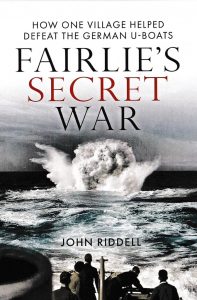Colin Tucker describes John Riddell’s new book as ‘a fascinating read about a virtually unknown aspect of the Clyde’s maritime history’.
 The arrival of any new book on the Clyde is always of interest, and even more so when it involves Clyde steamers. ‘Fairlie’s Secret War’ is a welcome addition to the many books on the river and firth. I must admit that my knowledge of Fairlie is somewhat limited. I remember it from the 1960s when I sailed from there to Arran and, if I remember correctly, to Millport, and from passing through on a train bound for Largs. Of the ‘Secret War’ I knew nothing.
The arrival of any new book on the Clyde is always of interest, and even more so when it involves Clyde steamers. ‘Fairlie’s Secret War’ is a welcome addition to the many books on the river and firth. I must admit that my knowledge of Fairlie is somewhat limited. I remember it from the 1960s when I sailed from there to Arran and, if I remember correctly, to Millport, and from passing through on a train bound for Largs. Of the ‘Secret War’ I knew nothing.
Local history is of great importance, especially when it relates to events on a much larger scale, in this case global. As John Riddell writes in his introduction, this ‘is a story about people and a small seaside village, and how the village played host to a very secret establishment that made a major contribution to the Second World War.’
The ‘establishment’ was His Majesty’s Anti-Submarine Experimental Establishment Fairlie, part of the Royal Navy, and as the name infers, a place where experiments were carried out into methods of combatting German U-boats. It was in operation from October 1940 until February 1946.
John Riddell came about the story almost by chance, starting from a plaque in the local church, and from there his research took him to wartime Fairlie, and into the realms of marine acoustics, hydrophones and underwater warfare. Much of what went on was classified information, and both staff and locals were sworn to secrecy, meaning that there was a limited number of sources from which John could draw; the local newspaper contained only censored items, while few who lived then are alive today, and fewer appear to have told much about what went on. John is to be commended, therefore, on gathering enough information to piece together the goings-on at the Establishment.
The original research base, HMS Osprey, had been located at Portland, being moved to the Clyde for safety reasons. There were four bases on the Firth: the headquarters based in a convalescent home at Dunoon, practical training carried out at Campbeltown, in the grammar school, and in the shallow waters at Ardrishaig. This book concentrates solely on the base at Fairlie, the only one not to have been given an ‘HMS’ name.

The MacBrayne paddle steamer Pioneer (renamed HMS Harbinger) moored off Fairlie in December 1945. After her role in Fairlie’s ‘secret war’ was concluded, the former Islay mail steaner had her paddles removed in February 1946 at Inglis of Pointhouse, where she had been built in 1905, and was towed to Portland Harbour for use as a floating laboratory
The background is set with a brief history of Fairlie itself and its yacht building business. This is followed by the technical pages, giving an understandable explanation of the science of underwater acoustics. As the author states, ‘those wishing a much more scientific and comprehensive explanation’ could look to a more detailed work. For a non-scientist like me, John’s explanation was quite sufficient.
Then there is the human side — mainly concerned with those who were working at the Establishment. But the locals are also mentioned, as is the interaction between the two. A chapter is devoted to the ships which were involved. These are not just naval vessels, for the base used a number of small cargo ships, and it is interesting to read about the involvement of the former Macbraynes paddle steamer Pioneer, renamed Harbinger. We learn about the Clyde steamers left to carry on services from the pier at Fairlie, and there is an atmospheric image of the turbine Glen Sannox in her drab wartime grey.
The story does not end with the end of the war. The writer describes the relaxation of life in 1945-46, the closure of the base and the departure of staff by train for the south. In a postscript John discusses the success or otherwise of the research at the base, the post-war development of submarines and anti-submarine warfare. After reading this section, when I see a Royal Navy submarine stealthily making its way up or down the Clyde, I will look at it with a different interest. The book ends with a brief look at Fairlie today.
‘Fairlie’s Secret War’ is a fascinating read about a virtually unknown aspect of the Clyde’s maritime history. John Riddell is to be commended for piecing together a history of what was a secret activity from the small amount of information, both written and oral, that he has discovered. He has also found plenty of illustrations to add interest to his readable text. He wonders whether he should have continued to dig for more information; I would say that he has found enough to tell us the story of ‘Fairlie’s Secret War’.
Fairlie’s Secret War: How One Village Helped Defeat German U-Boats by John Riddell. Paperback 219 pages. Published by Birlinn Ltd, £14.99. In addition to internet outlets, the book can be bought locally at Timberbooks in West Kilbride, WH Smith in Largs and several other Clydeside booksellers.
See also: John Riddell — Steamers and Harbours of the Clyde’s South Coast
Published on 16 November 2022











